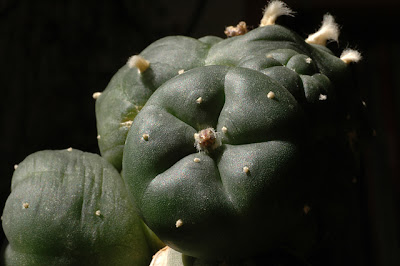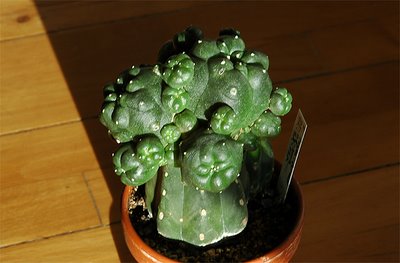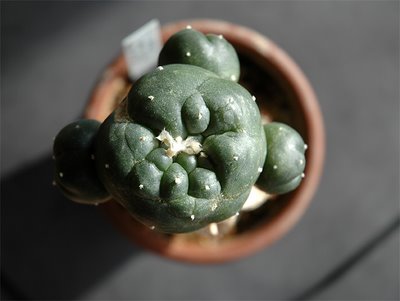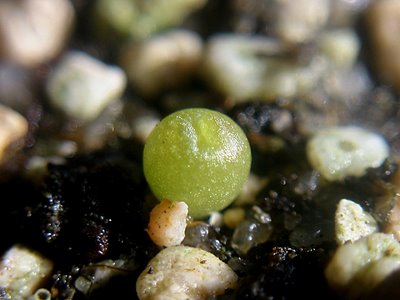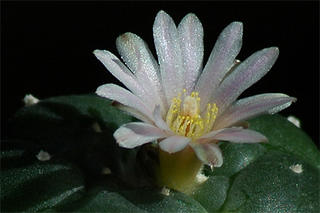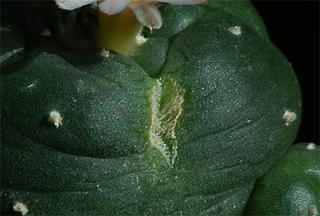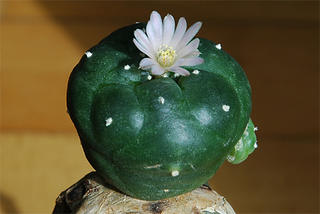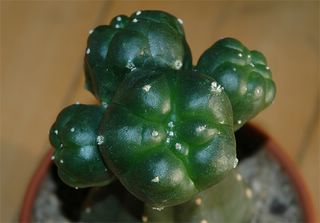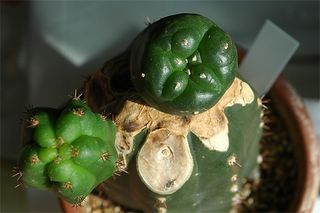First a bit of background information so that you guys won’t believe that I am completely stupid growing Lophophora and the likes in an unheated greenhouse in Denmark: 1) Most of these plants are “surplus”, i.e. I don’t have room for them anywhere else – lately several plants have been bought specifically for the cold house, though. 2) The greenhouse is located at my summerhouse, left mostly desolate throughout winter, making it difficult to keep it reliably heated. 3) Many cactus species tolerate more frost than is generally assumed; I’m curious which. 4) The winters in Denmark have been rather mild lately, inviting experiments like this.
With this in place I’m ready to recount how the harsh winter, that has just released its cold grip of Denmark, helped me separate the wheat from the chaff (a blatant euphemism for “killing off alarmingly large parts of my collection”). Just to give an understanding of the severity of the winter, the plants saw almost constant frost for more than 10 weeks, with temperatures measured as low as -15 C (5 F) in the area where the plants grow.
Lophophora williamsii var. echinata coming out of winter
Let’s start with one of the success stories. My Trans-Pecos peyote plants are doing quite well, approximately one in eight died and the surviving plants are not too marked by the frost. The plants I'm growing are descending from material originally collected in the Pecos River area, Val Verde County, Texas (JJH 8608293). The Trans-Pecos peyote is the northernmost form of Lophophora williamsii and is also known as Lophophora williamsii var. echinata.
Trans-Pecos peyote surviving the frost
My regular (Mexican and south Texan) Lophophora williamsii plants fared much worse, less than one in ten of the larger plants survived the winter. 
One of the few surviving Lophophora williamsii var. williamsii
This corresponds well with Del Weniger’s observations:
[Lophophora williamsii var. echinata] can also survive the much more severe cold of the Big Bend. I have several times had the smaller form from south Texas [L. williamsii var. williamsii] freeze in San Antonio, while this form [L. williamsii var. echinata] growing in the same bed showed no ill effects.
In the future I'll focus more on the extreme northern forms of peyote, i.e. plants grown from material originating from Shafter, Val Verde, Big Bend and other Trans-Pecos, Texas locations. The Cactus Conservation Institute has an informative page on the differences in traits between Lophophora williamsii var. echinata and var. williamsii.

Frost killed Lophophora williamsii, Starr County, Texas
As mentioned the majority of my large “regular” Lophophora williamsii were killed by the frost. But many medium sized seedling plants actually survived while the larger plants (of the same variety) and yearling seedlings succumbed. As this pattern seems to be rather consistent for plants of the same variety, I guess I can’t write all “regular” Lophophora williamsii casualties off to genetics. My theory is that this “size-conditioned” difference in survival must be related to how well the plants were prepared for the winter, which again may be closely related to the surface-area-to-volume ratio of the plant.
The surface-area-to-volume ratio (SA:V) decreases with size, i.e. a large plant will have less surface per unit of volume than a smaller plant. If we use a half sphere as a model for a globular cactus we get a SA:V of 3/r, where r is the radius. Consequently a large plant will need relatively longer time (per unit of volume) to go flaccid and prepare properly for the winter (as all excess water needs to be evaporated through the surface (the epidermis)). Similarly seedlings are more prone to die of drought as an increased SA:V means increased exposure to the environment in general.
To play it safe the coming growing seasons I'll stop watering my large plants well before I let seedlings go drought dormant in preparation for the winter, and in general start winter preparations earlier than I have used to in the past.
I might consider crossing the surviving mature (non Trans-Pecos) plants and name the cultivar Lophophora williamsii 'Borealis' ;-)

Frost killed Leuchtenbergia principis – outside the rain is weeping
My largest Leuchtenbergia principis is dead (pictured above next to a surviving saguaro) while 3 out of 4 of my smaller Leuchtenbergia principis plants (GL 770; Sierra de la Paila) are looking happy.
Ariocarpus has turned out to be an unconditional coldhouse success. I expected my Ariocarpus fissuratus plants to make it safely through the winter as they originate from locations like Fort Stockton, Texas (JM 122) and Crockett County, Texas (SB 403), but I had doubts about my Ariocarpus kotschoubeyanus var. macdowellii plants (SB 100; El Pilar, Coahuila), and had accepted that I would probably loose my Ariocarpus retusus (SB 310; Cuesta la Muralla, Coahuila). Amazingly they all survived the winter in great style almost looking lush and vigorous, like a winter swimmer surfacing with renewed energy after a cold plunge.

Surviving Ariocarpus, Epithelantha, and Leuchtenbergia plants
Epithelantha is another seriously cold tolerant genus. My Epithelantha micromeris var. greggii plants (Cuesta la Muralla, Coahuila, Mexico) all made it; one is seriously damaged, though – it looks like the root is dead while the crown looks fine, so I hope to be able to re-root it. The Epithelantha bokei plants (SB 416; Brewster Co, Texas) also look fine, but due to the extremely dense spination it is hard to say for sure if they are completely undamaged. Strangely the cold has taken the hardest toll on my regular Epithelantha micromeris (SB1327; near Belen, New Mexico) – this variety of E. micromeris is from the northernmost known locality of the species so I had expected the plants to cope better with the frost.

Surviving Obregonia denegrii plants
Last summer I moved a handful of Obregonia denegrii seedlings (VVZ 163; San Vicente, Tamaulipas) to the coldhouse. I really didn’t expect these plants to be cold hardy, but didn’t have room for them anywhere else. Surprisingly approximately two thirds of the plants survived as illustrated in the above picture (the surrounding pots are not empty, each contain a rather large L. williamsii killed by the cold).
Other success stories are Normanbokea valdeziana, Homalocephala texensis, and Mammillaria meiacantha which all made it through the winter without casualties – the Normanbokea plants are even budding. Acharagma roseana is another species that’s shaking off the winter blues and getting ready to bloom – in general Acharagma seems to handle the cold pretty well, even most of my yearling Acharagma aguirreana seedlings survived. Most Escobaria and Echinocereus obviously had minimal problems with the frost.

Frost killed Lophophora williamsii turning to mush
As mentioned above the majority of my larger, regular Lophophora williamsii plants were killed by the frost, but the more tender Lophophora species like Lophophora diffusa and L. fricii are completely eradicated – I’ll probably not experiment further with these species in the coldhouse, the exception maybe being montane varieties of Lophophora fricii.

Dead Lophophora diffusa
Other species that are completely wiped out include Matucana madisoniorum, an unknown Echinopsis hybrid, Ferocactus glucescens (PP 1354), Lithops lesliei (not exactly a cactus, I know ;-), and Harrisia jusbertii. Surprisingly all my Mammillaria grahamii also died – I had expected this species to be more cold hardy.
Most of my saguaro cactus (Carnegiea gigantea) also succumbed to the frost – 4 plants look like they might survive, most of them badly damaged, but it is too early to say.
I need to start building a new collection of grafting stock – all Trichocereus plants that I grew in the coldhouse are dead, including Trichocereus pachanoi, T. peruvianus, Trichocereus 'Tom Juul’s Giant', and a Penis Cactus… they are all gone. Even plants that were well prepared for the winter died, so Trichocereus is definitely not as tolerant to frost as I had expected.
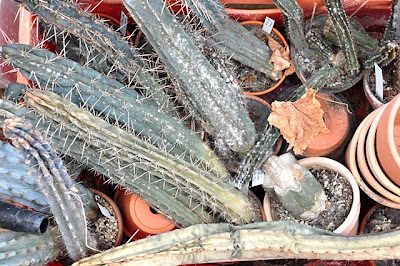
Decomposing Trichocereus plants
To put the death toll into perspective this is the coldest winter in 14 years in Denmark (followed by March, a month with the most extreme temperature fluctuations in 14 years, which were not very becoming to my struggling plants either). The frost set in just before Christmas and only lifted again in the beginning of March. The lowest temperatures measured in the area were as low as -15 C (5 F).

Outdoor temperature in late January
Once in a while short bursts of thaw set in quickly followed by frost (as indicated by the above graph), making the conditions even harder for the plants.

Outdoor temperature in mid February
The temperature measurements come from a semi-professional weather station located approximately 1.5 km (~ one mile) from where I grow my plants, so these temperatures are representative for those that my plants where exposed to.
To end on a positive note I expect the frost to have killed off many pests also (including red spider mites). Also, I got an affirmative confirmation that it is actually possible for peyote to survive rather extreme conditions in an unheated greenhouse in Denmark... and I got plenty of room for new plants ;-)
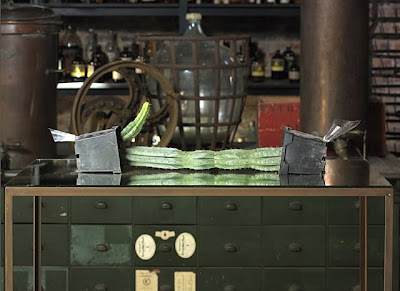






_20070421.jpg)
_20070421.jpg)
